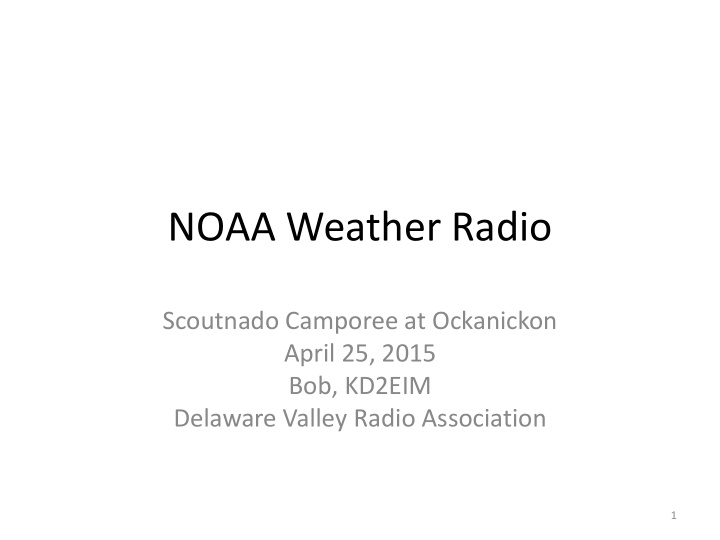



NOAA Weather Radio Scoutnado Camporee at Ockanickon April 25, 2015 Bob, KD2EIM Delaware Valley Radio Association 1
Let’s start with a question. . . Why do we have weather? The Earth rotates on a tilted axis. Due to the tilt, the equator is always heated more than either pole. 2
Mixing of warm and cold air results. . . 3
Not just temperature differences… Air which stays over water for long periods of time absorbs some of the moisture through evaporation. 4
Mixing of warm and cold air results in weather 5
Weather Forecasting • This problem has two parts . . . – Analyze: What’s going on right now – Forecast: What’s going to happen? • There are 3 basic methods of forecasting: – Persistence – tomorrow will be like today – works great in summer – Experience - forecast that was seen before to repeat – good for 1 or 2 days – Computer Modeling – works great most of the time – except when you have bad data 6
Weather Data Sources Surface Observations Radar Satellite 7 Cooperative Observers: SkyWarn
Sources of Weather Forecasts • All weather forecasts in the US, no mater what the source, are based on National Weather Service (NWS) data and computer models. • Commercial weather enterprises such as radio, TV and Weather.com, just put a pretty pictures on it and dumb it down • The commercial spin is designed to make it more exciting, not more accurate! 8
You can avoid weather bias • Know where to get unbiased locality specific forecasts • Know where to get time specific forecasts • Understand the uncertainty of the forecast 9
National Weather Service (NWR) • NWR’s Primary Mission: The protection of lives and property • Issues forecasts and advisories, watches, and warnings, for: -Severe Thunderstorms -Tornados -Floods -Flash Floods -Winter Storms 10
For Current Weather Information NOAA Weather Radio • Provides Scouts with weather forecasts in remote wilderness places without cellphone coverage • NOAA Weather Radio receivers with Specific Area Message Encoding (SAME) can automatically turn themselves on to warn you about dangers such as tornados in your county while you're asleep • 1025 transmitters, covering all 50 states, adjacent costal waters, Puerto Rico, the US Virgin islands and U.S. Pacific territories • Broadcasts are found in the VHF service band at 7 frequencies: 162.400, 162.425, 162.450, 162.500, 162.525, 162.550 Mhz 11
Locality Specific Forecasts • 122 Weather Forecast Offices (CONUS, AK, HI, Guam and Puerto Rico) Site Name Call Sign Frequency Atlantic City KHB38 162.400 Lakewood KZZ31 162.450 Philadelphia K1H28 162.475 12
Forecast Realities • NWS naturally errs on the side of caution; weather is more often better than forecast and rarely worse • Advisory: Just so you know… • Watch: Stay Alert! • Warning: Take Cover Now! • Follow the old Norwegian folk saying: – “There’s no such thing as bad weather, only bad clothing” 13
Amateur Radio Training and Licensing • For information about upcoming training classes and exam sessions, please contact the Delaware Valley Radio Association Director of Training & Exams – Don Wright, AA2F – AA2F@arrl.net or visit the Delaware valley radio Associations website www.w2zq.com 14
QUESTIONS? You can view or download the slides at www.W2ZQ.com/dvra-online-library 15
Recommend
More recommend